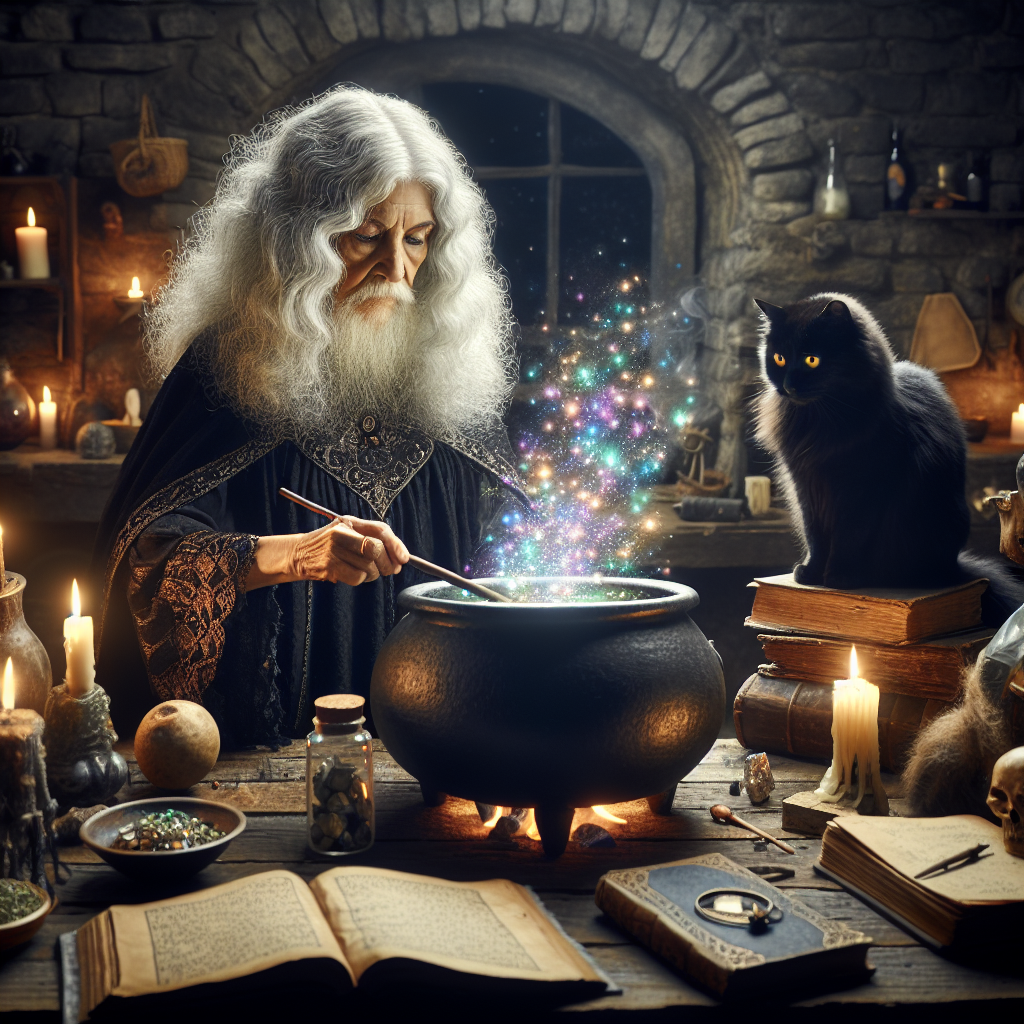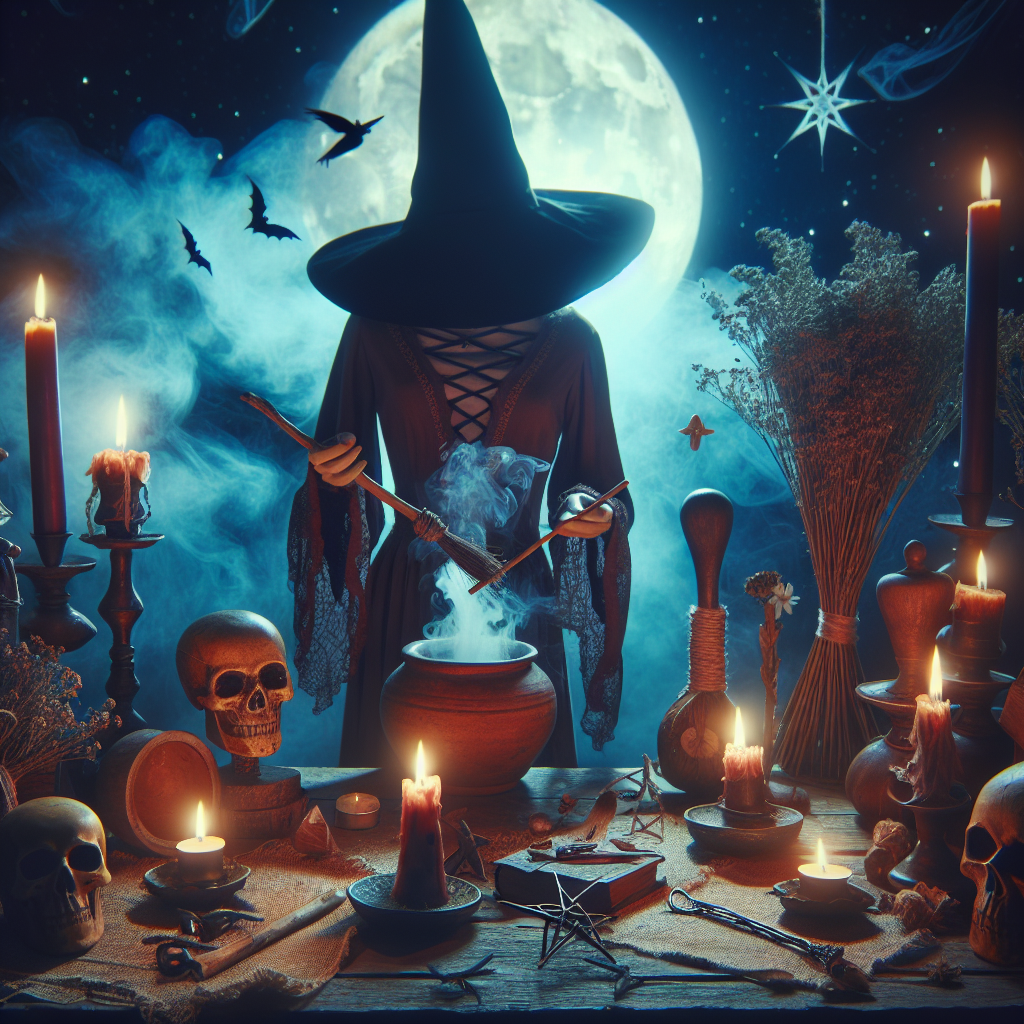As an Amazon Associate I earn from qualifying purchases.
Exploring Witchcraft in Spanish: Traditions and Practices can be a fascinating journey into the mystical world of spellcasting, divination, and spiritual practices deeply rooted in Spanish culture. Dating back centuries, Spanish witchcraft combines elements of indigenous beliefs, Catholic rituals, and traditional folklore. Today, this ancient practice continues to hold significant relevance, providing individuals with a sense of connection to their heritage and offering a path to understanding the forces that shape their lives.
Witchcraft in Spanish culture has been deeply intertwined with the land and the spiritual beliefs of indigenous communities. These traditions were further influenced by the arrival of Catholicism during the Spanish Inquisition. As a result, a unique blend of pagan and Christian elements emerged, creating a rich tapestry of magical practices. From herbal medicine to divination rituals, spellcasting to communicating with spirits, Spanish witchcraft encompasses a wide range of practices that have been passed down through generations.
One captivating aspect of exploring witchcraft in Spanish traditions is the integration of Catholic symbols and rituals. For instance, Santa Muerte, also known as Holy Death, is a figure venerated in Mexican and Latin American witchcraft. Despite being considered controversial within Catholicism, many Spanish witches incorporate prayers and offerings to Santa Muerte in their magical workings. This blending of faiths not only displays the resilience of Spanish witchcraft but also reflects the enduring power of cultural heritage in the face of religious changes.
Today, witchcraft in Spanish traditions and practices continues to thrive, captivating both practitioners and those who are curious about alternative spiritual paths. Recent studies show a growing interest in witchcraft among modern Spaniards, with an increasing number seeking guidance through spellcasting, tarot readings, and other magical rituals. In a fast-paced and uncertain world, exploring these ancient traditions provides individuals with a sense of empowerment and agency, allowing them to tap into their own intuition and establish a deeper connection with the forces governing their lives.
In conclusion, exploring witchcraft in Spanish traditions and practices offers a captivating journey into a world where spirituality and magic intertwine. With its rich history and relevance in modern times, Spanish witchcraft serves as a gateway to understanding cultural heritage and connecting with ancestral wisdom. Whether one chooses to engage in spellcasting, divination, or other magical practices, exploring witchcraft allows individuals to cultivate a deeper sense of self and forge a stronger bond with the natural and spiritual realms.
What are the traditions and practices of Witchcraft in Spanish?
Witchcraft in Spanish refers to the traditional beliefs, practices, and rituals related to magic and spell-casting within Spanish-speaking cultures. It encompasses a wide range of cultural and regional variations, often deeply rooted in folklore and ancient traditions. By exploring the rich tapestry of witchcraft in Spanish, we can gain a deeper understanding of the diverse practices and rituals that have been passed down through generations. In the following sections, we delve into the fascinating world of Witchcraft in Spanish, examining its history, common traditions, and the significance of its practices in contemporary society.
Exploring Witchcraft in Spanish: Traditions and Practices
Traditional witchcraft holds a prominent role in many cultures around the world, and Spain is no exception. In Spanish folklore and culture, witchcraft, known as “brujería,” has a rich history that dates back centuries. From ancient beliefs to modern practices, witchcraft in Spanish traditions encompasses a wide range of rituals, spells, and beliefs.
One of the most well-known aspects of Spanish witchcraft is the belief in “curanderas” or healers. These women, often referred to as witches, possess knowledge of herbal remedies and spiritual healing. They are known to have inherited their abilities from past generations and use their wisdom to cure ailments and provide guidance to their communities.
In addition to healers, Spanish witchcraft also includes a fascination with divination and fortune-telling. Techniques such as tarot card reading, palmistry, and scrying are commonly used to gain insights into the future and uncover hidden truths. Many people in Spain, even those who do not identify as witches, seek out these divination practices for guidance and clarity in their lives.
Furthermore, the practice of magic spells and potions is deeply ingrained in Spanish witchcraft. Many practitioners believe in harnessing the power of nature, which includes the use of herbs, crystals, and other natural elements to cast spells and manifest their desires. These spells can range from love and protection to healing and prosperity, and are often performed during specific moon phases or on significant dates within the lunar calendar.
While witchcraft in Spanish traditions may have historical roots, it continues to evolve and adapt to modern times. In recent years, there has been a resurgence of interest in witchcraft, not only as a spiritual practice but also as a form of self-empowerment and personal exploration. Many individuals, particularly younger generations, are drawn to the mysticism and alternative spirituality that witchcraft offers.
According to a recent survey, over 30% of young Spanish individuals have shown an interest in witchcraft and have sought out resources, such as books, workshops, and online communities, to learn more about it. This growing trend signifies a shift in attitudes towards spirituality and a desire to reconnect with ancient wisdom and practices.
In conclusion, the exploration of witchcraft in Spanish traditions and practices reveals a deep-rooted belief in magic, healing, and divination. From the curanderas who provide spiritual guidance and physical healing to the use of spells and potions, witchcraft in Spanish culture continues to captivate and intrigue individuals of all ages. The resurgence of interest in recent years highlights the lasting influence and relevance of witchcraft in Spanish society, making it a significant aspect of their cultural heritage.
1. What is witchcraft in Spanish?
Witchcraft in Spanish, known as “brujería,” refers to a set of traditional and spiritual practices deeply rooted in the Hispanic culture. It involves the use of herbs, potions, spells, and rituals to harness natural energies and influence various aspects of life.
2. Is witchcraft in Spanish the same as in other cultures?
While witchcraft practices share some similarities across cultures, witchcraft in Spanish has its unique characteristics. It incorporates elements from indigenous beliefs, Catholicism, and European folklore, creating a distinct blend of traditions and practices.
3. Can anyone practice witchcraft in Spanish?
Yes, anyone with an interest can practice witchcraft in Spanish. It is important to study and respect the traditions and customs involved, as well as seek guidance from experienced practitioners to ensure a respectful and accurate practice.
4. Are witchcraft and religion linked in Spanish culture?
Yes, in Spanish culture, witchcraft is often intertwined with religious practices, especially Catholicism. Many practitioners incorporate prayers, saints, and religious symbols into their rituals, combining elements of both witchcraft and religion.
5. Are there any dangers associated with practicing witchcraft in Spanish?
Like any spiritual or magical practice, the dangers associated with witchcraft in Spanish largely depend on how it is approached and practiced. It is crucial to respect the traditions and ethics involved, and to acknowledge the potential consequences of using magic for negative or harmful purposes.
6. How can one learn witchcraft in Spanish?
Learning witchcraft in Spanish requires dedication, research, and guidance from experienced practitioners. You can start by studying the history, beliefs, and practices of witchcraft in Spanish, and then seek out mentors, workshops, or online communities that can provide further knowledge and support.
7. Can witchcraft in Spanish be used for healing?
Yes, witchcraft in Spanish often includes healing practices. Traditional herbal remedies, energy work, and spiritual cleansings are common methods utilized to promote physical and emotional well-being.
8. Are love spells a part of witchcraft in Spanish?
Love spells are sometimes included in witchcraft practices in Spanish. It is important to approach such spells with caution and respect for the free will and consent of others, as manipulating someone's feelings against their will is considered unethical.
9. Is witchcraft in Spanish considered evil or Satanic?
No, witchcraft in Spanish is not inherently evil or Satanic. It is a spiritual practice rooted in the beliefs, traditions, and culture of the practitioner. It is crucial to avoid generalizations and stereotypes when discussing witchcraft in any culture.
10. Can witchcraft in Spanish help with daily life challenges?
Witchcraft in Spanish offers various tools and practices that can help individuals navigate daily life challenges. From providing guidance and protection to assisting with enhancing intuition and manifestation skills, witchcraft can be a beneficial resource for personal growth and empowerment.

Conclusion
In conclusion, this article has provided a comprehensive exploration of witchcraft in Spanish, shedding light on its rich traditions and practices. We began by delving into the historical background of witchcraft in Spain, highlighting the influence of diverse cultural and religious beliefs on this phenomenon. From there, we examined the various rituals and spells, emphasizing the importance of spells and charms in the practice of brujería. The role of different witches, such as hechiceras and curanderas, was also discussed, illustrating the diversity within witchcraft practices.
Furthermore, this article explored the significance of folklore and herbal medicine in Spanish witchcraft. The use of plants and herbs for healing purposes and spellcasting was examined, showcasing the deep connection between nature and the craft. Additionally, we delved into the perception of witchcraft in contemporary Spanish society, addressing the impact of superstitions and a renewed interest in the occult. Lastly, we touched upon the challenges faced by practitioners of witchcraft and how they strive to maintain their traditions in a modern world.
Overall, this article provides readers with a comprehensive understanding of witchcraft in Spanish. The deep-rooted traditions, diverse practices, and cultural significance underscore the importance of this ancient craft in Spanish history and society. By exploring the customs and beliefs associated with witchcraft, individuals can gain a greater appreciation for the rich tapestry of Spanish culture.
Amazon and the Amazon logo are trademarks of Amazon.com, Inc, or its affiliates.


